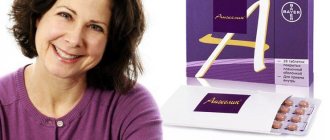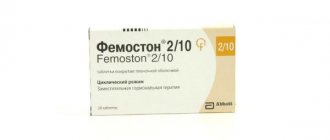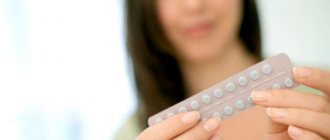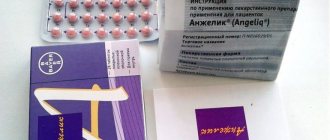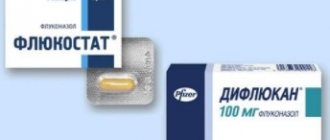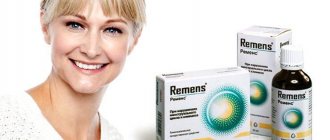Instructions for use
Femoston is a combination drug that is used for hormonal replacement treatment .
In the composition of the drug, estradiol is its estrogenic component, and dydrogesterone is a gestagenic component.
Estradiol acts as a component that compensates for the lack of estrogens (hormones) after the onset of menopause and provides the necessary treatment for vegetative and psycho-emotional manifestations :
- hyperhidrosis (increased sweating);
- feeling of "hot flashes";
- lack of oxygen in brain tissue;
- restless sleep;
- migraine;
- dryness of the vaginal mucosa, etc.
Estradiol can cause cyclic processes in the tissues of the vagina, cervix and uterus itself, due to which their elasticity will be maintained at the proper level, as well as the tone of the genitourinary tract. This component of the drug is aimed at preventing damage to the integrity of bones and loss of their strength, helping to preserve bone tissue.
Indications for use
Femoston is used for:
- the need for hormonal replacement treatment during the physiological onset of menopause or its development after surgical treatment
- prevention of changes in bone density in women after menopause.
Composition of the drug
One tablet contains:
- active ingredients: estanediol, dydrogesterone;
- excipients: corn starch, magnesium stearate, iron oxide, lactose monohydrate.
The average price of Femoston in pharmacy chains ranges from 1100 to 1900 rubles.
Femoston
1/10 and 2/10 are available for sale . The therapeutic effect of the drug is explained by estradiol and dydrogesterone.
You can expect the following from taking the medicine:
- Estradiol compensates for the lack of estrogen that occurs in women during menopause, thanks to which the signs of menopause decrease during the first weeks of therapy.
- Dydrogesterone normalizes the full secretory transformation of the endometrium and reduces the likelihood of excessive growth of the internal mucous membrane of the uterus.
The package contains 28 tablets, 14 of them contain estradiol, the rest also contain dydrogesterone.
Which is better: Femoston, Klimonorm or Angelique?
Drugs of similar composition for the correction of menopausal symptoms include Klimonorm and Angeliq.
Just like Femoston, these are combined (estrogen and gestagen) agents. The main difference between the drug Angelique is its monophasic nature and the presence of a progestin component in the form of drospirenone. The main indications for use of the drug are menopause and the prevention of osteoporosis associated with a lack of intrinsic estrogen.
The drug is available in the form of tablets 28 and 84 pcs. with constant dosage:
- estradiol 1 mg;
- drospirenone 2 mg.
Klimonorm differs from previous drugs in the dosage of the active ingredients. The package contains:
- 9 estradiol tablets with a dosage of 2 mg;
- 12 combination pills (estradiol 2 mg, levonorgestrel 150 mcg).
Thus, one cycle involves taking 21 tablets once a day and 7 days off. Thanks to this feature, the drug is used not only in eliminating the symptoms of menopause, but also for correcting the menstrual cycle in women of reproductive age.
Consider whether it is worth taking it: side effects from using Duphaston.
Reviews of doctors and patients about Femoston tablets can be read at our link.
How to determine if you have hepatitis C: https://venerolog-ginekolog.ru/venereology/zppp/lechenie-gepatita-c.html
Angelique
The therapeutic effect of Angelica is explained by estradiol and drospirenone.
The drug reduces the symptoms of menopause, such as:
- Feeling hot.
- Excessive sweating.
- Sleep disorder.
- Deterioration of mood.
- Myalgia and arthralgia.
- Irritability.
- Pain in the heart area.
- Weakening of sexual desire.
- Urine incontinence.
- Dryness and irritation in the vagina.
- Pain during sexual intercourse.
What do they have in common?
Femoston and Angelique have the following similarities:
- Both medications are prescribed as HRT during menopause and to reduce the risk of osteoporosis during this period.
- Children, pregnant women and breastfeeding women are not allowed to drink hormonal drugs.
- Both medications should not be taken if the patient has the following deviations from the norm: intolerance to the composition of the tablets, bleeding from the genital tract of unknown etiology, breast cancer and hormone-dependent malignant tumors, benign and malignant liver tumors, impaired liver function, thrombosis of veins and arteries. Treatment with these drugs should not be started if a woman is at high risk of developing vascular thrombosis. Patients with high blood pressure, fibroids, endometriosis, diabetes mellitus, migraine, systemic lupus erythematosus, bronchial asthma, and epilepsy should drink them with caution.
- Angelique and Femoston can cause migraines, arterial and venous thromboembolic complications, discomfort in the mammary glands, hormone-dependent tumors, vaginal bleeding, abdominal pain, depressed mood, irritability, weakened libido, liver pathologies, dementia, fibroid growth, cholestasis, allergies. , attacks of epilepsy, systemic lupus erythematosus, porphyria, bronchial asthma.
Manufacturers declare
Clinical studies have shown that Angelique:
- normalizes the psycho-emotional state;
- reduces the number of hot flashes, sweating and irritability. Effects on vasomotor symptoms (eg, hot flashes, night sweats) and vulvar and vaginal atrophy were generally observed within four weeks of treatment;
- relieves joint pain, headaches;
- dryness and itching in the vagina, discomfort during intimacy. Based on the results of clinical trials in 1,759 women, manufacturers declare that the drug is safe and effective in providing endometrial protection and cannot cause uterine cancer;
- due to estrogen deficiency during menopause, acting on bone cells - osteoclasts, prevents the occurrence of osteoporosis.
- The medicine also reduces blood glucose and insulin levels.
- Possessing an antiandrogenic effect, Angelique prevents hair loss, the formation of wrinkles and acne.
- Drospirenone prevents the appearance of edema in the body, as it has a diuretic effect.
- And what women are most afraid of, “Angelique” does not cause pain in the mammary glands and weight gain.
- Moreover, taking this drug, the amount of lipids is normalized, and the level of cholesterol in the blood plasma decreases.
In one 1-year large randomized controlled trial, Angeliq 2 mg significantly reduced mean body weight. On average, women lost 1.2 kg from baseline.
Comparison and how they differ
There are the following differences between Femoston and Angelique:
- You should not drink Angelique if you have impaired renal function, pulmonary embolism, or a marked increase in triglycerides in the blood. Femoston should not be taken if a woman has experienced migraine for the first time due to taking a hormonal drug, she has been diagnosed with porphyria, endometrial hyperplasia, or high blood pressure, which cannot be normalized by taking medications.
- Angeliq should be taken with caution by patients with pigmentary hepatosis, cholestatic jaundice during pregnancy, nicotine addiction, high cholesterol, excess weight, dementia, gallbladder pathologies, eye vascular thrombosis, edema caused by chronic renal failure, porphyria, low calcium levels and low potassium content in the blood. Femoston should be taken with caution by women with a history of endometrial hyperplasia, otosclerosis, cholelithiasis, and hormone-dependent tumors in close relatives.
- Angelique can cause stones in the bile ducts, increased blood pressure and triglyceride levels, polyps in the cervix, changes in glucose tolerance, hyperpigmentation, common chorea, and otosclerosis. Femoston can provoke cephalgia, dizziness, nausea, vomiting, bloating, changes in vaginal secretions, thrush, back pain, inflammation of the bladder and pancreas, swelling of the extremities, impotence, weight gain and loss, hemolytic anemia, leg cramps, enuresis, cervical erosion, increased levels of thyroid hormones and triglycerides.
Angelique and Femoston for menopause
Both Femoston and Angelique belong to replacement therapy drugs - they contain hormones that the body does not produce during menopause. According to the International Anatomical Therapeutic Classification, they are coded as combination drugs containing estrogens and gestagens. They are usually prescribed a certain time after the last menstruation. Femoston is produced by the Dutch, Angelique - by the German Bayer Pharma, AG. Both companies have rightly earned the trust of the Russian consumer. Angelique is slightly more expensive.
Patients are interested in which drug to choose during menopause. You should know that there is no better medicine. The best is what is effective for each specific patient. What helped a friend or interlocutor on the site get rid of the side effects of menopause can harm another woman with absolutely similar clinical manifestations.
How do these drugs work?
With a decrease in the production of female hormones, many representatives of the fair sex may experience symptoms that cause inconvenience and reduce the quality of life. In order to reduce the paroxysmal nature of hot flashes, slow down atrophic changes in the vagina, stabilize the psycho-emotional sphere and reduce the risk of osteoporosis, doctors recommend replacement therapy. Moreover, experience shows that this approach has beneficial effects on other areas of the body, for example, reducing the incidence of cardiovascular diseases.
Imitating the hormonal background of the reproductive period is the principle of creating drugs such as Femoston and Angeliq for use during menopause.
Composition and release form
Pharmacies sell Femoston and Angelica blisters containing 28 tablets. Both drugs are similar in composition in the presence of estradiol - it belongs to the most active female sex hormones, estrogens, and differ in the composition of gestagens - steroid female hormones that take part in the functioning of the hypothalamic-pituitary-ovarian system.
Action Each package contains 28 tablets. The gestagens in Angelica are represented by drospirenone, and in Femoston, half of the blister tablets contain dydrogesterone. The drugs have a number of excipients.
Estradiol is one of the active components, chemically and biologically similar to estrogen. Replenishes its deficiency during menopause. Capable of relieving psycho-emotional and vegetative manifestations of menopausal syndrome - hot flashes, hyperhidrosis, sleep disorders, migraine attacks, excessive irritability, aging of the skin and mucous membranes. Normalizes metabolic processes in bone tissue, eliminating the phenomena of osteoporosis.
Estrogens, along with a number of positive properties, can provoke the growth of the endometrium, causing cancer of the inner lining of the uterus. In order to reduce the risk of such exposure, Angelica and Femoston contain synthetic progestogens - dydrogesterone or drospirenone. They are also called progestins.
Drospirenone helps to increase the removal of fluid and sodium ions from tissues, which helps reduce edema. Various clinical studies have confirmed that neither drospirenone nor dydrogesterone have androgenic, glucocorticoid, or mineralocorticoid effects during menopause.
Varieties of Femoston (“1”, “2”, “Mini”, “Conti”) and the difference from Angelica (regular and “Micro”)
A special feature of the drug is its dosage form in the form of 2 tablets: one contains only estradiol, and the second contains a combination of estradiol + dydrogesterone. This is necessary in order to most fully reflect fluctuations in female sex hormones during the menstrual cycle. Therefore, to replace hormones in the initial 14 days of the cycle, the first Femoston tablet is used, and in the remaining days - the second (see numbers “1” and “2” on the blister pack).
Mono- and combined tablets are produced with two concentrations of estradiol, the content of dydrogesterone in them is the same (10 mg). This is reflected in the name Femoston:
- “1” – 1 mg (1/10),
- “2” – 2 mg (2/10).
In addition, like Angelique, the drug is available in the form of a single tablet with:
- 1 mg estradiol and 5 mg dydrogesterone - “Conti”,
- 0.5 mg estradioloa and 2.5 mg dydrogesterone - “Mini”.
Thus, in terms of the concentration of estradiol in this packaging, there is no difference between Angelique and Femoston.
Comparative table of compositions
| Femoston | Angelique | ||||
| «1» | «2» | "Conti" | "Mini" | Ordinary | "Micro" |
| Amount of estradiol (mg) | |||||
| 1 | 2 | 1 | 0,5 | 1 | 0,5 |
| Amount of dydrogesterone (mg) | |||||
| 10 | 5 | 2,5 | — | ||
| Amount of drospirenone (mg) | |||||
| — | 2 | 0,5 | |||
Indications
Given the identical composition of the drugs, Angelique and Femoston have the same indications. Manufacturers warn how long after the last menstruation you can start taking it.
Purpose of prescribing Angelica or Femoston:
- replenishment of hormone deficiency;
- prevention of osteoporosis in the postmenopausal period.
Angelique and Femoston are indispensable for correcting calcium metabolism if a woman has contraindications to non-hormonal drugs for the treatment of osteoporosis.
Directions for use and dosage
For optimal selection of the drug and dosage, it is important to inform the doctor in detail about the timing of the last menstruation. Hormonal medications are taken every 24 hours. It is recommended to choose the most convenient appointment time depending on your habits and personal daily routine. Medicines are used continuously; a new package must be started the next day after the previous one is completed.
When for any reason the scheduled appointment is late, it is important to take the pill as quickly as possible. If you cannot take the medicine within 24 hours, you do not need to take a double dose.
If the patient is taking other cyclic hormonal medications, in order to prevent adverse events, it is necessary to complete the course of taking the previous medication. If a woman is menstruating, the first day of her appointment must be coordinated with a specialist.
When prescribing Femoston 1/10 or Femoston 2/10, tablets that do not contain dydrogesterone are first taken, they are marked on the blister packaging with a one, and for the next 14 days - with the addition of gestagen (marked with a two).
Comparison of side effects of Femoston and Angelica micra
Side effects or adverse events are any adverse medical event that occurs in a subject after administration of a drug.
Angelica micra has more side effects than Femoston. This implies that the frequency of their occurrence is low in Angelica micra and low in Femoston. Frequency of manifestation is an indicator of how many cases of an undesirable effect from treatment are possible and registered. The undesirable effect on the body, the strength of influence and the toxic effect of drugs are different: how quickly the body recovers after taking it and whether it recovers at all. When using Angelica micra, the body's ability to recover faster is higher than that of Femoston.
Contraindications
The similar composition of Femoston and Angelica causes the same contraindications for their use. It is unlikely that pregnancy will be suspected during menopause, or the woman will have to breastfeed the baby, however, it should be remembered that these conditions are categorical contraindications.
Both drugs are prohibited if:
- vaginal bleeding of any etiology;
- oncohematological diseases;
- history of thromboembolic conditions or threats of thrombus formation;
- liver and kidney dysfunctions;
- endometrial hyperplasia;
- disorders of porphyrin metabolism;
- intolerance to individual components.
Be sure to inform the specialist if the patient:
- arterial hypertension;
- metabolic syndrome;
- endometriosis or fibroids;
- bronchial asthma;
- otosclerosis;
- migraine attacks;
- cholelithiasis;
- systemic connective tissue diseases;
- epileptic disease.
It is important to inform the attending physician about all medications that are prescribed to the patient, since the effect of estrogens can be enhanced or weakened when interacting with certain medications, as well as change the metabolism of certain chemicals.
What is better during menopause: indications for the use of drugs
Taking into account the fact that the composition of the products is almost the same, the indications for their use are also identical. Manufacturers inform you how long after the last menstruation you should start taking it; a woman can also check this information with a gynecologist.
Femoston and Angelique for menopause are prescribed for the purpose of:
- replenish the lack of female hormones;
- prevention of osteoporosis during menopause;
- normalization of calcium metabolism;
- treatment of osteoporosis in women, in case of contraindications to taking non-hormonal drugs.
Femoston and Angelique for menopause: instructions
In order for the specialist to correctly select the product and its dosage, the woman must report the date of her last menstruation. The hormonal drug is taken after a day.
It is advisable to choose the most favorable and convenient time for taking pills, and correlate it with your daily routine and habits. Medicines must be taken continuously, i.e. open and start taking a new package the day after the previous one is finished.
If for some reason the dosage hour was missed, it is advisable to take the pill as quickly as possible. If it is impossible to take the medicine within 24 hours, a double dose is not needed.
If a woman is prescribed other hormonal drugs, in order to prevent the occurrence of unpleasant phenomena, she should first complete the course of taking the previous medication. If a woman is menstruating, the first day of taking the product should be agreed with a specialist.
Taking femoston during menopause (1/10 or 2/10). First, tablets that do not contain dydrogesterone are taken. They will be marked -1 on the packaging. In the next 2 weeks - with gestagen content, mark on the blister - 2.
Contraindications
The identity of the composition of the drugs also determines the similarity of contraindications for taking the drugs.
Of course, during menopause a woman cannot be pregnant or breastfeeding, but these conditions fall into the prohibited category of using Femoston and Angelica.
Both drugs are prohibited if a woman has:
- bleeding (uterine, vaginal), which have any etiology;
- diseases of oncohematological type;
- threats of blood clots or in the presence of thromboembolic conditions;
- disorders of the liver or kidneys;
- endometrial hyperplasia;
- disturbances in porphyrin metabolism;
- individual intolerance to certain components included in the preparations.
A woman must notify her doctor if she has:
- arterial hypertension;
- metabolic syndrome;
- fibroids or endometriosis;
- asthma;
- atherosclerosis;
- migraine attacks;
- cholelithiasis;
- epilepsy.
The patient must inform the doctor about all medications taken, because the effect of estrogens can increase or decrease when interacting with certain medicinal components, and can also lead to changes in the metabolism of chemicals.
Side effects
Most women experience spotting and spotting from the vagina when starting therapy with Angelique or Femoston. Often when taking hormones, there is swelling or tenderness of the mammary glands, attacks of headaches, episodes of depression, and irritability.
Some women experience a decrease in libido, loss of appetite - both increase and decrease and, as a result, may gain or lose weight. There may be discomfort from the digestive system, muscle spasms or joint pain, pathological skin manifestations such as acne, itching, visual disturbances, and urinary tract diseases.
Quite rare adverse events are a decrease in hemoglobin levels, the formation of gallstones, chills, ringing in the ears, cerebrovascular and cardiac disorders, difficulties in using contact lenses, as well as some other side effects of hormone therapy.
It is important to immediately inform your doctor about any manifestation. When using hormone therapy during menopause, it is necessary to be examined annually by a specialist to adjust the dosage.
Angelique or Femoston for menopause
Depending on the manifestations of menopause, the presence of concomitant diseases, and ovarian function, the specialist will advise the woman which drug - Angelique or Femoston - will be most effective for her. It is important not to be left alone with the problem, but to consult a competent doctor. Life is beautiful and amazing at any age; you shouldn’t poison it with torment about choosing the best drug. The attending physician will do this.
Sources:
https://100lkrstv.com/gormony/femoston.html https://vchemraznica.ru/femoston-ili-anzhelik-sravnenie-i-chto-luchshe/ https://ginekola.ru/klimaks/chto-luchshe-pri -klimakse-anzhelik-ili-femoston.html
